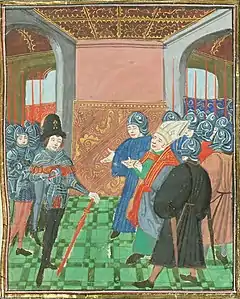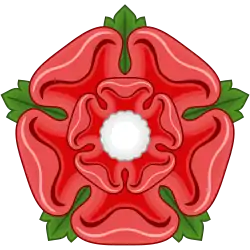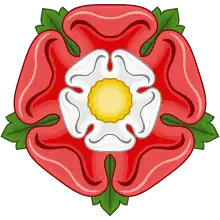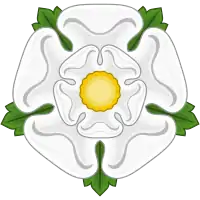Edmund Beaufort | |
|---|---|
 Edmund Beaufort (left) negotiating with French envoys at Rouen, from the Chronique of Jean Chartier, c. 1470–80 | |
| Born | 1406 |
| Died | 22 May 1455 (aged ~49) St Albans, Hertfordshire, England |
| Resting place | St Albans Abbey |
| Nationality | English |
| Opponent | Richard, Duke of York |
| Spouse | Eleanor Beauchamp |
| Children | 10, including: |
| Parent(s) | John Beaufort, 1st Earl of Somerset Margaret Holland |
| Family | Beaufort |
| Military career | |
| Battles/wars | Hundred Years' War Wars of the Roses |
| Awards | Order of the Garter |
.svg.png.webp)
Edmund Beaufort, 2nd Duke of Somerset, 4th Earl of Somerset, 1st Earl of Dorset, 1st Marquess of Dorset styled 1st Count of Mortain,[lower-alpha 1] KG (1406 – 22 May 1455), was an English nobleman and an important figure during the Hundred Years' War. His rivalry with Richard, Duke of York, was a leading cause of the Wars of the Roses.
Origins
Edmund Beaufort was the fourth surviving son of John Beaufort, 1st Earl of Somerset, the eldest of the four legitimised children of John of Gaunt (1340–1399) (third surviving son of King Edward III) by his mistress, later wife, Katherine Swynford. Edmund's mother was Margaret Holland, a daughter of Thomas Holland, 2nd Earl of Kent, by his wife Alice FitzAlan, a daughter of Richard FitzAlan, 10th Earl of Arundel, by his wife Eleanor of Lancaster, fifth daughter of Henry, 3rd Earl of Lancaster, a grandson of King Henry III. Edmund was thus a cousin of both Richard, Duke of York, and the Lancastrian King Henry VI.[2]
Career
Although he was the head of one of the greatest families in England, his inheritance was worth only £300. By contrast his rival, Richard, Duke of York, had a net worth of £5,800. His cousin King Henry VI's efforts to compensate Somerset with offices worth £3,000 only served to offend many of the nobles, and as Somerset's quarrel with York grew more personal, the dynastic situation got worse. Another quarrel with Richard Neville, Earl of Warwick, over the lordships of Glamorgan and Morgannwg may have forced the leader of the younger Nevilles into York's camp.
His brothers were taken captive at the Battle of Baugé in 1421, but Edmund was too young at the time to fight. He acquired much military experience while his brothers were prisoners.
Affair with Catherine of Valois
In 1427 it is believed that Edmund Beaufort may have embarked on an affair with Catherine of Valois, the widow of King Henry V. Evidence is sketchy; however, the liaison prompted a parliamentary statute regulating the remarriage of queens of England. The historian G. L. Harriss surmised that it was possible that another of its consequences was Catherine's son Edmund Tudor and that Catherine, to avoid the penalties of breaking the statute of 1427–1428, secretly married Owen Tudor. He wrote: "By its very nature the evidence for Edmund Tudor's parentage is less than conclusive, but such facts as can be assembled permit the agreeable possibility that Edmund 'Tudor' and Margaret Beaufort were first cousins and that the royal house of 'Tudor' sprang in fact from Beauforts on both sides."[3]
Political power and conflict

Edmund received the county of Mortain in Normandy on 22 April 1427,[5] became a commander in the English army in 1431, and in 1432 was one of the envoys to the Council of Basel.[6] After his recapture of Harfleur and his lifting of the Burgundian siege of Calais, he was named a Knight of the Garter in 1436. After subsequent successes he was created Earl of Dorset on 28 August 1442 (though he seems to have been styled as such since around 1438)[7] and Marquess of Dorset on 24 June 1443.[8][9] During the five-year truce from 1444 to 1449 he served as Lieutenant of France. On 31 March 1448 he was created Duke of Somerset.[10] As the title had previously been held by his brother, he is sometimes mistakenly called the second duke,[11] but the title was actually created for the second time, and so he was actually the first duke, the numbering starting over again.
Somerset was appointed to replace York as commander in France in 1448. Somerset was supposed to be paid £20,000; but little evidence exists that he was. Fighting began in Normandy in August 1449. Somerset's subsequent military failures left him vulnerable to criticism from York's allies.[12] The most humiliating moment was when Somerset surrendered Rouen, the capital of Normandy, to the French without even a token siege. He failed to repulse French attacks, and by the summer of 1450 nearly all the English possessions in northern France were lost, with Normandy having fallen after the Battle of Formigny and Siege of Caen. By 1453 all the English possessions in the south of France were also lost, and the Battle of Castillon ended the Hundred Years War.
The fall of the duke of Suffolk left Somerset the chief among King Henry VI's ministers, and the Commons in vain petitioned for his removal in January 1451.[6] Power rested with Somerset and he virtually monopolised it, with Margaret of Anjou, wife of King Henry, as one of his principal allies. It was also widely suspected that Somerset had an extra-marital affair with Margaret. After giving birth to a son in October 1453, Margaret took great pains to quash rumours that Somerset might be his father. During her pregnancy Henry suffered a mental breakdown, leaving him in a withdrawn and unresponsive state that lasted for one-and-a-half years. This medical condition, untreatable either by court physicians or by exorcism, plagued him throughout his life. During Henry's illness, the child was baptised Edward, Prince of Wales, with Somerset as godfather; if the King could be persuaded, he would become legal heir to the throne.
Somerset's fortunes, however, soon changed when his rival York assumed power as Lord Protector in April 1454 and imprisoned him in the Tower of London. Somerset's life was probably saved only by the King's seeming recovery late in 1454, which forced York to surrender his office. Henry agreed to recognise Edward as his heir, putting to rest concerns about a successor prompted by his known aversion to physical contact; subsequently he came to view Edward's birth as a miracle.[13][14] Somerset was honourably discharged, and restored to his office as Captain of Calais.
By now York was determined to depose Somerset by one means or another, and in May 1455 he raised an army. He confronted Somerset and the King in an engagement known as the First Battle of St Albans, which marked the beginning of the Wars of the Roses. Somerset was killed in a last wild charge from the house where he had been sheltering. His son, Henry, never forgave York and Warwick for his father's death, and spent the next nine years attempting to restore his family's honour.
Marriage and children
At some time between 1431 and 1433, Somerset married Eleanor Beauchamp, daughter of Richard de Beauchamp, 13th Earl of Warwick, by his first wife Elizabeth de Berkeley, daughter and heiress of Thomas de Berkeley, 5th Baron Berkeley. Eleanor was an elder half-sister of Henry de Beauchamp, 1st Duke of Warwick, and Anne de Beauchamp, 16th Countess of Warwick, wife of Richard Neville, 16th Earl of Warwick, known as the "Kingmaker". The marriage was without royal licence, which offence was pardoned on 7 March 1438. By his wife he had issue including:
Sons
- Henry Beaufort, 3rd Duke of Somerset (26 January 1436 – 15 May 1464),[15] eldest son and heir, who was beheaded after the Battle of Hexham, where he commanded the Lancastrian troops. He died unmarried, but left an illegitimate son by his mistress Joan Hill:
- Charles Somerset, 1st Earl of Worcester, 1st Baron Herbert (c.1460-1526), KG, who was given the surname "Somerset" and was created Baron Herbert in 1506 and Earl of Worcester in 1513. From him descend the Earls and Marquesses of Worcester and the present Dukes of Beaufort.
- Edmund Beaufort, 4th Duke of Somerset (1439 – 6 May 1471),[15] who succeeded his elder brother. He was executed two days after being defeated in the Battle of Tewkesbury, in which he commanded the van of the Lancastrian army, and was buried in Tewkesbury Abbey. Died unmarried, the last of the male line, when "the house of Beaufort and all the honours to which they were entitled became extinct".[16]
- John Beaufort, Earl of Dorset (1441[17] – 4 May 1471),[15] killed fighting for the Lancastrians during the Battle of Tewkesbury, two days before his elder brother's execution. Died unmarried.
- (Thomas Beaufort (1442–1517), another son identified by Alison Weir, but not by the traditional sources[18])
Daughters
Following the death of all their brothers without issue, fighting for the Lancastrian cause, they became co-heiresses to their father, and their descendants were thus entitled to quarter the arms of Beaufort.

- Eleanor Beaufort (Countess of Ormond) (between 1431 and 1433 – 16 August 1501), who married firstly James Butler, 5th Earl of Ormond, and secondly Sir Robert Spencer (d. pre-1510), of London and Bridport, Dorset,[18] also of Ashbury in Devon;[20] frequently stated erroneously in credible sources[21] to be of Spencer Combe, Crediton, Devon. One of the two daughters and co-heiresses of Sir Robert Spencer by his wife Eleanor Beaufort was Margaret Spencer (1472–1536) (or Eleanor), who married Thomas Cary of Chilton Foliat in Wiltshire, the younger son of William Cary (1437–1471) of Cockington and Clovelly in Devon, whose descendants included Cary, Viscount Falkland; Cary, Baron Hunsdon; Cary, Baron Cary of Leppington, Earl of Monmouth; and Cary, Viscount Rochfort, Earl of Dover,[22] all of whom quartered the arms of Beaufort.
- Joan Beaufort (1433 – 11 August 1518), married firstly Robert St Lawrence, 3rd Baron Howth, and secondly Sir Richard Fry.[18][23]
- Anne Beaufort (1435 – 17 September 1496),[18][24] who married Sir William Paston (1436 – before 7 September 1496),[25] a younger son of William Paston (1378–1444), Justice of the Common Pleas.[26]
- Margaret Beaufort, Countess of Stafford (1437–1474),[27][28] married firstly Humphrey, Earl of Stafford and secondly Sir Richard Darell, of Littlecote (in Ramsbury), Wiltshire.[15]
- Elizabeth Beaufort (1443 – before 1475),[29] married Sir Henry Fitz Lewis.[18]
- Mary Beaufort (born between 1431 and 1455)[18]
Ancestry
| Ancestors of Edmund Beaufort, 2nd Duke of Somerset | ||||||||||||||||||||||||||||||||||||||||||||||||||||||||||||||||||||||||||||||||||||||||||||||||||||||||||||||||||||||||||||||||||||||||||||||||||||||||||||||||||||||||||||||||||||||||||||||||||||||||||||||||||||||||||||||||||||||||||||||||||||||||||||||||||||||||||||||||||||||||||||||||||||||||||||||||||||||||||||||||||||||||||||||||||||||||||||||||||||||||||||||||||||||||||||||||||||||||||||||||||||||||||||||||||||||||||||||||||||||||||||||||||||||||||||||||||||||||||||||||||||||||||||||||||||||||||||||||||||||||||||||||||||||||||||||||||||||||||||||||||||||||||||||||||||||||||||||||
|---|---|---|---|---|---|---|---|---|---|---|---|---|---|---|---|---|---|---|---|---|---|---|---|---|---|---|---|---|---|---|---|---|---|---|---|---|---|---|---|---|---|---|---|---|---|---|---|---|---|---|---|---|---|---|---|---|---|---|---|---|---|---|---|---|---|---|---|---|---|---|---|---|---|---|---|---|---|---|---|---|---|---|---|---|---|---|---|---|---|---|---|---|---|---|---|---|---|---|---|---|---|---|---|---|---|---|---|---|---|---|---|---|---|---|---|---|---|---|---|---|---|---|---|---|---|---|---|---|---|---|---|---|---|---|---|---|---|---|---|---|---|---|---|---|---|---|---|---|---|---|---|---|---|---|---|---|---|---|---|---|---|---|---|---|---|---|---|---|---|---|---|---|---|---|---|---|---|---|---|---|---|---|---|---|---|---|---|---|---|---|---|---|---|---|---|---|---|---|---|---|---|---|---|---|---|---|---|---|---|---|---|---|---|---|---|---|---|---|---|---|---|---|---|---|---|---|---|---|---|---|---|---|---|---|---|---|---|---|---|---|---|---|---|---|---|---|---|---|---|---|---|---|---|---|---|---|---|---|---|---|---|---|---|---|---|---|---|---|---|---|---|---|---|---|---|---|---|---|---|---|---|---|---|---|---|---|---|---|---|---|---|---|---|---|---|---|---|---|---|---|---|---|---|---|---|---|---|---|---|---|---|---|---|---|---|---|---|---|---|---|---|---|---|---|---|---|---|---|---|---|---|---|---|---|---|---|---|---|---|---|---|---|---|---|---|---|---|---|---|---|---|---|---|---|---|---|---|---|---|---|---|---|---|---|---|---|---|---|---|---|---|---|---|---|---|---|---|---|---|---|---|---|---|---|---|---|---|---|---|---|---|---|---|---|---|---|---|---|---|---|---|---|---|---|---|---|---|---|---|---|---|---|---|---|---|---|---|---|---|---|---|---|---|---|---|---|---|---|---|---|---|---|---|---|---|---|---|---|---|---|---|---|---|---|---|---|---|---|---|---|---|---|---|---|---|---|---|---|---|---|---|---|---|---|---|---|---|---|---|---|---|---|---|---|---|---|---|---|---|---|---|---|---|---|---|---|---|---|---|---|---|---|---|---|---|---|---|---|---|---|---|---|---|---|---|---|---|---|---|---|---|---|---|---|---|---|---|---|---|---|---|---|---|---|---|---|---|---|---|---|---|---|---|---|---|---|---|---|---|---|---|---|---|---|---|---|---|---|---|---|---|---|---|---|---|---|---|---|---|---|---|---|---|---|---|---|---|---|---|---|---|---|---|---|---|---|---|---|---|---|---|---|---|---|---|---|---|---|---|---|---|---|
| ||||||||||||||||||||||||||||||||||||||||||||||||||||||||||||||||||||||||||||||||||||||||||||||||||||||||||||||||||||||||||||||||||||||||||||||||||||||||||||||||||||||||||||||||||||||||||||||||||||||||||||||||||||||||||||||||||||||||||||||||||||||||||||||||||||||||||||||||||||||||||||||||||||||||||||||||||||||||||||||||||||||||||||||||||||||||||||||||||||||||||||||||||||||||||||||||||||||||||||||||||||||||||||||||||||||||||||||||||||||||||||||||||||||||||||||||||||||||||||||||||||||||||||||||||||||||||||||||||||||||||||||||||||||||||||||||||||||||||||||||||||||||||||||||||||||||||||||||
Footnotes
Notes
- ↑ GenUK
- ↑ Farquhar 2001.
- ↑ Richmond 2004, p. 1
- ↑ de Wavrin, Jean (2012), Hardy, William; Hardy, Edward L.C.P. (eds.), Recueil des chroniques et anchiennes istories de la Grant Bretaigne, à present nommé Engleterre, vol. 5, Cambridge University Press, pp. 120–146, ISBN 9781108047845, the start of Chapter 3 of Volume 6
- ↑ Cokayne & White 1953, p. 49.
- 1 2 One or more of the preceding sentences incorporates text from a publication now in the public domain: Kingsford, Charles Lethbridge (1911). "Somerset, Edmund Beaufort, Duke of". In Chisholm, Hugh (ed.). Encyclopædia Britannica. Vol. 25 (11th ed.). Cambridge University Press. p. 386.
- ↑ Cokayne & White 1953, p. 49–50.
- ↑ Cokayne & White 1953, p. 50.
- ↑ Richardson 2011, p. 43.
- ↑ Cokayne & White 1953, p. 51.
- ↑ Humphrys Family Tree
- ↑ Kingsford 1911.
- ↑ Norton, Elizabeth (2012), Margaret Beaufort: Mother of the Tudor Dynasty, Amberley Publishing, ISBN 978-1445607344, Chapter 3
- ↑ Ashdown-Hill, John (2015), The Wars of the Roses, Amberley Publishing, ISBN 978-1445645322, Chapter 3
- 1 2 3 4 Weir, page 105
- ↑ G. E. Cokayne, The Complete Peerage, n.s., XII, Part 1, p.58
- ↑ Richardson, Vol. IV. p. 653
- 1 2 3 4 5 6 Alison Weir, Britain's Royal Family: A Complete Genealogy (London: The Bodley Head, 1999), p. 106
- ↑ Kidd, Charles, Debrett's Peerage & Baronetage 2015 edition, London, 2015, p. 441
- ↑ Douglas Richardson, Plantagenet Ancestry: A Study in Colonial And Medieval Families, 2nd edition, p. 480
- ↑ i.e. Debrett's Peerage, The Complete Peerage
- ↑ Vivian, Lt. Col. J.L. (ed.), The Visitations of the County of Devon: Comprising the Heralds' Visitations of 1531, 1564 & 1620, Exeter, 1895, pedigree of Cary, pp. 150–155
- ↑ Paget, Gerald. The Lineage and Ancestry of H.R.H. Prince Charles, Prince of Wales, Vol. I, p. 23
- ↑ Douglas Richardson (2013) Royal Ancestry, Vol. IV, p. 654
- ↑ Richardson, Vol. IV, p. 502
- ↑ Davis 1971, p. lvii.
- ↑ Cokayne, George Edward. The Complete Peerage of England, Scotland, Ireland, Great Britain, and the United Kingdom, Vol. II, p. 422
- ↑ Richardson, Vol. IV, p. 503
- ↑ Richardson, Vol. IV, p. 655
- 1 2 Weir 2008, p. 92.
- ↑ Weir 2008, p. 232.
- 1 2 3 4 Brown 2004.
- 1 2 3 Weir 2008, p. 93.
- ↑ Weir 2007, p. 6.
- ↑ Marshall 2003, p. 50.
- 1 2 Browning 1898, p. 288.
- 1 2 3 Weir 2008, p. 125.
- 1 2 Weir 2008, pp. 94–95.
- 1 2 Weir 2008, pp. 97, 104.
- ↑ Weir 2008, pp. 94, 125.
- 1 2 3 Weir 2008, p. 77.
References
- Brown, M.H. (2004). "Joan [Joan Beaufort] (d. 1445)". Oxford Dictionary of National Biography (online ed.). Oxford University Press. doi:10.1093/ref:odnb/14646. (Subscription or UK public library membership required.)
- Browning, Charles H. (1898). The Magna Carta Barons and Their American Descendants. London: Genealogical Publishing Company.
- Cokayne, G. & White, G.H., eds. (1953). The Complete Peerage. Vol. 12 (2nd ed.). London: St. Catherine Press.
- Davis, Norman, ed. (1971). The Paston Letters and Papers of the Fifteenth Century, Part I. Oxford: Clarendon Press. ISBN 9780197224212. Retrieved 20 September 2013.
- Farquhar, Michael (1 May 2001). A Treasury of Royal Scandals: The Shocking True Stories History's Wickedest, Weirdest, Most Wanton Kings, Queens. Penguin Books. ISBN 978-1-101-01039-6.
- Marshall, Rosalind (2003). Scottish Queens, 1034-1714. Tuckwell Press.
- Richardson, D. (2011). Kimball G. Everingham (ed.). Magna Carta Ancestry. Vol. 4 (2nd ed.). Salt Lake City, UT. ISBN 978-1-4609-9270-8.
{{cite book}}: CS1 maint: location missing publisher (link) - Richmond, Colin (2004). "Beaufort, Edmund, first duke of Somerset (c. 1406–1455)". Oxford Dictionary of National Biography (online ed.). Oxford University Press. doi:10.1093/ref:odnb/1855. (Subscription or UK public library membership required.)
- Weir, Alison (2007). Mistress of the Monarchy: The Life of Katherine Swynford, Duchess of Lancaster. London: Random House. ISBN 978-0-345-45323-5.
- Weir, Alison (18 December 2008). Britain's Royal Families: The Complete Genealogy. London: Vintage Books. ISBN 978-0-09-953973-5.
Further reading
- Griffiths, R.A. (1981). The Reign of King Henry VI. London: Ernest Benn. ISBN 0-510-26261-9.
- Harriss, G.L. (1988). Cardinal Beaufort: A Study of Lancastrian Ascendancy and Decline. Oxford: Clarendon Press. ISBN 0-19-820135-4.
- Jones, Michael K. (1982). The Beaufort family and the war in France, 1421–1450 (PDF) (PhD). University of Bristol. OCLC 71194555.
- Jones, Michael K. (1989). "Somerset, York and the Wars of the Roses". English Historical Review. 104 (411): 285–307. doi:10.1093/ehr/CIV.CCCCXI.285. JSTOR 571736.
- Jones, Michael K. (1994). "The Relief of Avranches (1439): An English Feat of Arms at the End of the Hundred Years War". In Nicholas Rogers (ed.). England in the Fifteenth Century: Proceedings of the 1992 Harlaxton Symposium. Harlaxton Medieval Studies (new series). Vol. 4. Stamford, UK: Paul Watkins. pp. 42–55. ISBN 1-871615-67-4.
External links
- The Beaufort family Archived 27 May 2018 at the Wayback Machine Retrieved 26 May 2018


